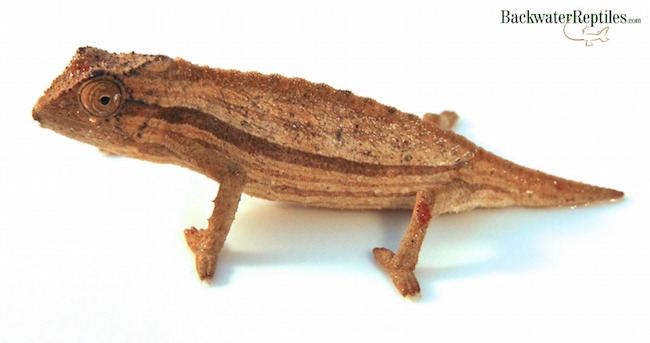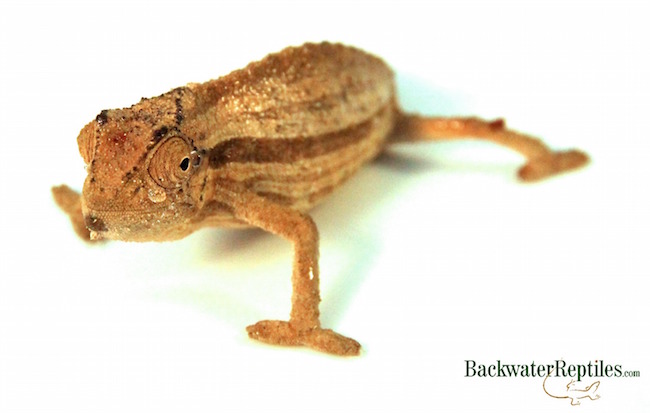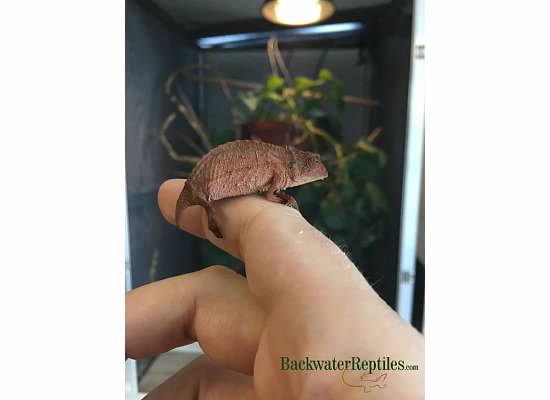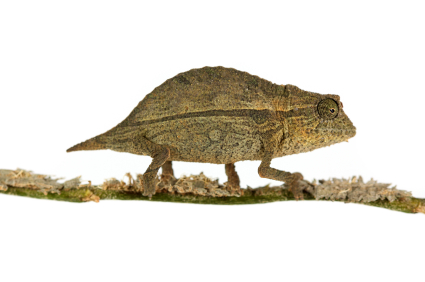Unique in many ways, and we’re going to list the top ten Pygmy chameleon facts. When most people think of a chameleon, the animal that comes to their mind is a bright, color-changing lizard with a curlicue tail and eyes that can move in opposite directions. However, at Backwater Reptiles, we have some pygmy chameleons that don’t adhere to the chameleon “stereotype.” This blog entry is dedicated to shedding light on these unique little chameleons by providing readers with ten quick facts about them.
1. Unlike their more colorful, larger cousins, pygmy chameleons tend to be shades of brown with various blotches, spots, and stripes. While they can still adjust their color depending on their surroundings, they do not turn shades of bright green, blue, or orange.
2. Pygmy chameleons are also known as Stump-tail chameleons because they have short, truncated tails. Because they live on leaf litter on the ground, they don’t require curly, long tails that allow them to grasp tree branches like their arboreal cousins.

3. As their name suggests, pygmies get no larger than three and a half inches and some species will stay as small as an inch long. They also have relatively short lifespans averaging from one to three years.
4. Pygmy chameleons can be housed communally. Provided they live in an enclosure with enough space, food, and humidity, they will coexist happily.
5. When keeping pygmies in captivity, horizontal space is more important than vertical space. These little guys are not big on climbing like most arboreal chameleons. It’s also a great idea to have lots of floor roaming space if you have more than one male in a single enclosure because it gives them territory to “claim” and less chance to encounter each other and engage in aggressive behavior.

6. Pygmies are avid breeders and because they can be housed together, you’ll need to watch out for gravid females. You can tell when a female is gravid because, like a pregnant human, she will swell up really large in the tummy region. Make sure you watch gravid females closely as it’s not necessary to move pygmies to a separate laying bin when it’s time to lay eggs. The substrate kept year-round in a pygmies’ enclosure should be moist enough and provide enough digging depth for a female to deposit her eggs.
7. Juvenile and baby pygmy chameleons should be fed as many pinhead crickets a they can consume daily. Adults should be consuming approximately four to six small crickets every other day.

8. When frightened, pygmies can vibrate or buzz in order to attempt to intimidate other chameleons or predators. They definitely aren’t lacking in the personality department.
9. Because they live in leaf litter, pygmies do everything they can to camouflage in with the leaves. Interestingly enough, they can compress their bodies and flatten out to resemble a dead leaf and believe us when we say that if they don’t want to be found, sometimes it’s hard to see them even when they’re right in front of your face!
10. Pygmy chameleons make great pets! Pygmies are usually pretty docile and don’t mind being handled by people. Just be aware of the animal’s posture and behavior while handling because like most chameleons, stress is dangerous to their health.

If you are interested in owning a tiny, unique, and quirky animal, Backwater Reptiles has pygmy chameleons for sale. We bet you’re going to want multiples. ;-)


